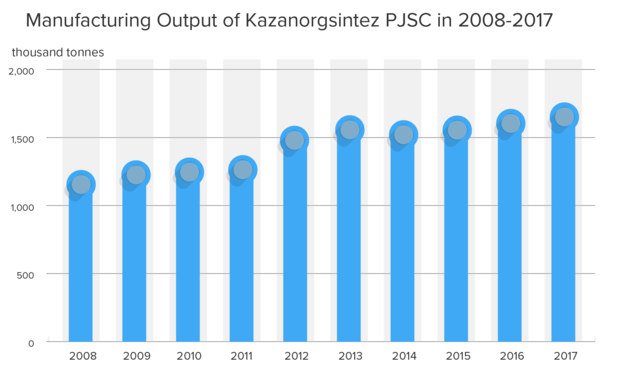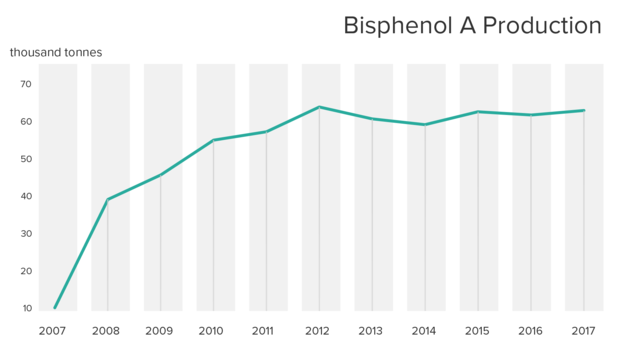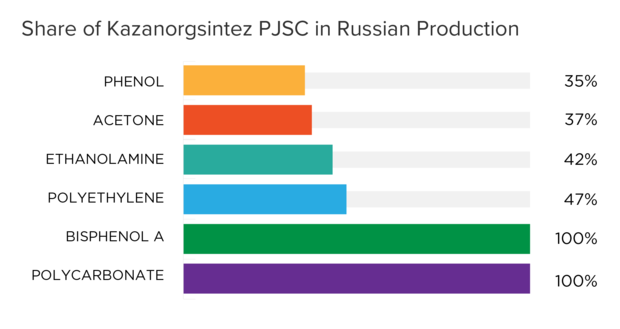Persistent 'petrochemical flagship': how to survive in the 90s, build new plants and solve crises
Over 60 years of its history, Kazanorgsintez has faced different problems but has always coped with them saving and developing factories
One of the leading petrochemical companies of Russia Kazanorgsintez PJSC celebrates a double jubilee this year – 60 years since its foundation and 55 years since the first product was made. There have been both active construction and big crises during these years. But Kazanorgsintez is one of few enterprises in Tatarstan that didn't stop its production in the most difficult years, didn't refuse its main business and paid its workers a salary. KOS not only survived in the 90s when it seemed the collapse would be inevitable, but also it managed to create new cutting-edge products in the noughties. Realnoe Vremya tells the details.
'Chemist's birthday in Kazan: launch of first factories
All chemical factories of the USSR switched to a new feedstock in the late 50s – associated petroleum gas produced in oil regions. It partly became a reason to build a new chemical factory near Kazan. This is how the foundation of the Kazan organic synthesis factory was laid in 1958, which later became one of the flagships of the country's chemical industry and revenue generating company of the republic. The factory got the first product in the summer of 1963. Only one plant had been launched by this time, while the enterprise's annual capacity totalled 45,000 tonnes of phenol and 27,500 tonnes of acetone.

Since the first days, the enterprise has been aimed to not only increase production but also master new petrochemical products. Construction in the factory didn't stop, new shops and plants were put into operation every year. The first stage of the ethylene plant was commissioned in 1965, the second one – in 1968. Ethylene-100 industrial unit – the third stage of the ethylene plant – joined the operation in 1974. Its capacity amounted to 100,000 tonnes of ethylene a year, which is modest by today's standards.

The ethylene plant was created for their own needs – as a feedstock to produce polyethylene. This is why polyethylene capacities were implemented almost simultaneously: the first stage of the high-density polyethylene plant appeared in 1965 (capacity of 24,000 tonnes a year), the second stage of the HDPE plant was in 1968 (capacity of 48,000 tonnes a year), the third stage of the HDPE plant kicked off in 1976 (capacity of 120,000 tonnes a year).
New shops to manufacture organic synthesis products were built, infrastructural and social facilities were erected at the same time: accommodation for factory workers, Chemists' Culture Palace, a swimming pool, recreational centres and so on.

Before Perestroika, in 1982, the fourth stage of the ethylene plant with a capacity of 200,000 tonnes a year and a completely new factory – low-density polyethylene plant – was launched at Kazanorgsintez.
On the verge of dissolution: how petrochemical flagship overcame economic storms in the 90s
The factory welcomed the transition from the controlled to the market economy with high production indicators. For instance, in 1988, the enterprise produced over 170,000 of low-density polyethylene, over 184,000 tonnes of high-density polyethylene and ultrathene. The enterprise became stronger and was standing on his own two feet. However, it had to learn how to work in the new conditions and create its economy on its own. There weren't Komsomol construction projects and financial support from all over the country. It had to solve all problems at its own expense – new facilities, modernisation of equipment, infrastructural development.
The dissolution of the country, shutdown of enterprises, reduction in the domestic market, loss of previous business links hit Kazanorgsintez. Problems in feedstock supply and sale of products began at the same time. By 1991, production volumes had reduced. Low-density polyethylene production volumes dropped to 154,000 tonnes, high-density polyethylene and ultrathene fell to 168,000 tonnes.

Mainly export saved it from a financial collapse. In 1987, Kazanorgsintez created its own external trade firm. The enterprise started to sell its products abroad bypassing state intermediaries. Exports provided with currencies, which were so needed when the ruble was devaluing. The enterprise began to create its own unrelated areas that helped both the plants and factory workers to withstand: its own agro-industrial complex, trade firms supplying food, clothes and other goods for the employees for reduced prices. The taken measures saved from the economic and social collapse. In the 90s, Kazanorgsintez was almost the only enterprise in the capital of Tatarstan where workers were paid a salary without delay. The enterprise also had to solve the problem of conservation of plants operating as a single mechanism. Plants began to leave the giant. Sevilen PJSC was created on the basis of the first-stage HDPE plant as early as 1991. In 1993, the enterprise itself transformed into Kazan Organic Synthesis Joint Stock Company.

In the late 90s, feedstock supply problems reached the peak. Nizhnekamskneftekhim, which was also surviving, also stopped feedstock supplies. And ethane supplies from Orenburg didn't allow to use the enterprise's capacities to the full.
The plants' technical state was also in trouble. The modernisation in the high and low-density polyethylene plants began in 1998. However, it became clear by early 2000 that the petrochemical flagship needed to modernise all production capacities after all the storms in the 90s.
Successes with new shareholder
The petrochemical enterprise couldn't be allowed to collapse. And the government of the Republic of Tatarstan charged TAIF PJCS, which already had rich experience in fulfilling petrochemical projects, with starting the work to consolidate the controlling interest of Kazanorgsintez PJSC's shares. In 2003, a new composition of the Supervisory Board of KOS was approved at the annual meeting of shareholders with Tatarstan Prime Minister Rustam Minnikhanov. TAIF PJSC Director General Albert Shigabutdinov was elected its chairman.

First of all, Kazanorgsintez's strategic development programme was created under the control of TAIF and the government of the Republic of Tatarstan. After its approval, they started negotiations with foreign companies, looked for new technologies, licensees. The factory workers were given ambitious tasks: to reconstruct the low-density polyethylene, phenol and acetone, ethylene plants, create bisphenol A and polycarbonate plants. The production of completely new products was arranged in the enterprise for the first time since the Soviet era, factories were built from scratch for the first time.
Technologies from Univation Technologies (USA) allowed the enterprise to master the production of linear and bimodal polyethylene in the reconstructed reactor in 2006, while licences and contracts with Idemitsu Kosan, Asahi Kasei and Toyo Engineering enabled to build new factories providing Kazanorgsintez with leadership in its sphere.
Reactors A and C were reconstructed in the low-density polyethylene production and refining plant increasing LDPE production capacities to 510,000 tonnes a year. The modernisation of the phenol and acetone plant allowed to augment capacities to 65,000 tonnes of phenol and 41,000 tonnes of acetone a year. The industrial production of products of the bisphenol A plant began in October 2007, while the first and the only polycarbonate plant in Russia started its operation in 2008. This new area of production inspired life to the first shops at Kazanorgsintez – phenol production shops.
The costs on the first stage of Kazanorgsintez PJSC Strategic Development Programme totalled 35 billion rubles from 2004 to 2008. At a meeting of Kazanorgsintez shareholders in 2008, Rustam Minnikhanov thanked the officials for the ''aggressive strategy'' that gave such a powerful result.

By late 2008, five years after Kazanorgsintez joined TAIF Group of Companies, the enterprise had been manufacturing over 320,000 tonnes of low-density polyethylene. High-density polyethylene production exceeded the result in 1988 and reached 203,000 tonnes.
How KOS solved financial crisis
The enterprise had just made its first steps towards recovery when it faced another obstacle – consequences of the world financial crisis. The crisis hit Kazanorgsintez when huge investments had been made, while financial results were ahead. The most important thing for the personnel and the enterprise was that they weren't abandoned when the company was on the verge of an economic collapse. The issue was discussed at the level of the country's government, and Sberbank was one of the first companies to express a desire to participate in debt restructuring. After long talks with Gazprom, the enterprise finally managed to sign a long-term contract with a formula-based price to supply ethane, the main feedstock to manufacture ethylene and then polyethylene. It was possible to make the deals thanks to the participation and surety of TAIF GC. In the end, all debts of Sberbank were paid off beforehand.
Debt restructuring allowed to complete Kazanorgsintez PJSC's development programme in 2010, which was adopted by the Council of Directors in 2004. The capital investments in the works done in 2010 in the development programme totalled 2,15bn rubles.
Enterprise's successes in numbers

Kazanorgsintez approached the double jubilee in 2018 with considerable successes: low-density polyethylene production increased almost 1,5 times in 10 years from 2007 to 2017. If in 2007 this indicator exceeded 301,000 tonnes, it was 507,000 tonnes in 2017. High-density polyethylene production also grew from over 197,000 tonnes in 2007 to 218,000 tonnes in 2017.

Products of Bisphenol A plant almost doubled since 2008 and was over 66 tonnes in 2017. Another new factory – polycarbonate plant – manufactured almost 69,000 tonnes of products last year.
Kazanorgsintez is one of the biggest foreign and domestic market players. Last year, it made almost half of all polyethylene in Russia – 727,000 tonnes against 1,7m tonnes. The use of production capacities increased from 97% in 2016 to 94% in 2017, while volume index totalled 101,7% compared to 2016.

Nowadays Kazanorgsintez keeps updating its production capacities. Four new pyrolysis furnaces will be put into operation in the ethylene plant late this year. It's planned to complete the ethylene plant's modernisation project in 2020. The most proximate plans also include the reconstruction of the isopropylbenzene plant with a new technology, modernisation of one of the three reactors in the low-density polyethylene plants, augmentation of capacities in the polycarbonate plant. So in 2021, the enterprise will be able to reach a revenue of at least 100bn rubles.